Menu
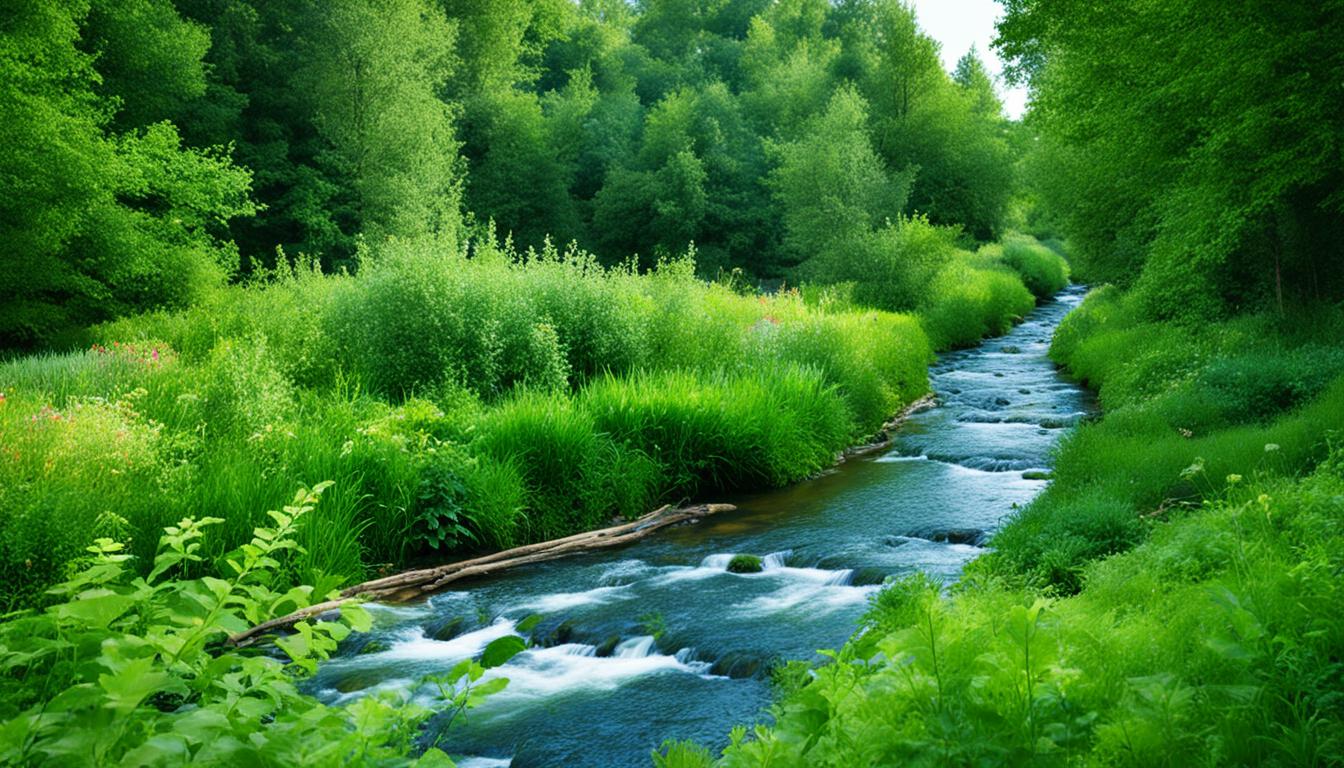
Did you know over 80% of diseases come from drinking dirty water, says the WHO? This shows how crucial it is to manage water quality well. Rather than waiting for problems, we should work proactively to keep water clean. It’s essential for the health of people and the planet, ensuring water is safe and enjoyable for all.
Managing water quality happens all the time. It involves watching the environment closely, looking at things like pH and nutrients. By keeping water clean, we help our health and the places animals and plants live in. This is because everything in nature is connected. So, making sure water is safe never stops; it’s a continuous effort.
Keeping our water safe is vital for life and the environment. It requires detailed knowledge of water’s physical, chemical, and life properties. The first step is a deep water quality assessment. This looks at things like oxygen levels, nutrients, metals, and more. Such checks help us set high standards and use the right methods to keep water clean.
One key goal is to monitor water quality. This job is done by experts at all levels of government and by certain groups. Places like the U.S. Geological Survey and the U.S. Environmental Protection Agency are involved. So are local leaders, tribal governments, and private groups. Many people who volunteer help monitor, too.
Monitoring can happen at different sites and times, like beaches in summer. It’s done to:
The data from these checks goes into systems like the EPA’s STORET. This info is used to make decisions on pollution and to plan ways to manage water better. Water treatment is vital as it aims to get rid of anything harmful to meet set quality standards.
Improving monitoring means making reporting clearer and simpler. National reports, like the National Water Quality Inventory, show how well our water is being looked after. These steps help make sure that water care is well-informed and open to everyone involved.
Keeping water clean is a big task that needs teamwork, science, and new ideas. A steady cycle of water quality checks and steps to fix any issues works to make our water ecosystems better.
Keeping water clean is key for a healthy society, safe ecosystems, and public safety. We must measure water quality to stop contamination early. This action reduces health risks and protects wildlife. It also keeps people safe.
It’s crucial to follow water quality rules as dirty water leads to over 80% of health problems. Unsafe water causes more than 1.2 million early deaths yearly. Improvements in areas like Monroe County, where most homes now use a central sewer, have cut these dangers. They got rid of many septic tanks that once polluted water.

Clean water supports a rich variety of life. Projects such as NOAA’s work on Florida’s coral reefs show how vital clean water is. The health of the Everglades benefits from projects that improve water flow. This shows how water quality connects to a thriving environment.
Contaminated water can be a big risk for people. That’s why efforts, like the Water Quality Protection Program, aim to keep water clean. This program works with key agencies to stop water pollution. It also fights problems like toxic algae and flooding.
Sadly, 26% of the world lacks safe drinking water, according to the World Health Organization. By enforcing strict water quality standards, we can reduce these risks. We’re working towards a safer, healthier world for everyone.
It’s vital to know the key water health indicators for good water quality control. The amount of oxygen in water is very important. Fish need between 9.5 and 12 mg/L of oxygen to live. If it’s less than 4.0 mg/L, fish might not survive. Keeping nitrate levels under 2 mg NO3-N/l helps most freshwater beings stay healthy.
The pH scale measures how acidic or alkaline the water is, on a scale of 0 to 14, where 7 is neutral. Pollutants and acid rain can change this, affecting water quality. Clear water is good, but it’s often reduced by too many Total Suspended Solids (TSS). Watching microalgae can tell us about pollution in the environment.
Changes in temperature can hurt aquatic life and water quality, impacting both oxygen levels and the likelihood of diseases. Real-time monitoring, like the tools from Sinay, gives us fast information for tackling problems. Advanced tech such as AI helps predict changes in the water. This aids in taking early actions to protect the environment.
Oxygen’s solubility in water changes with temperature and pressure. Aquatic life can’t survive in water with a pH below 4.5 or above 9.5. It’s crucial to keep the pH balanced. The range for Total Dissolved Solids (TDS) in water is usually 0 to 1,000 mg/L. Water conductivity is usually from 10 to 1,000 μS/cm.
While some metals like copper are necessary, they become dangerous at high levels. Mercury is very harmful due to bioaccumulation. Toxins like PAHs and PCBs make water quality control tough. It’s essential to always check and manage these key water health indicators.
Keeping our water quality in top shape needs careful environmental monitoring. Physical checks help gather data on water’s movement, depth, colour, and more. This data is key in checking how clean our water is.
It’s vital to know about water speed and how deep it is when we watch the environment. Water speed helps things move like mud and food for fish. Knowing the depth shows us where flooding might happen, so we can be ready.
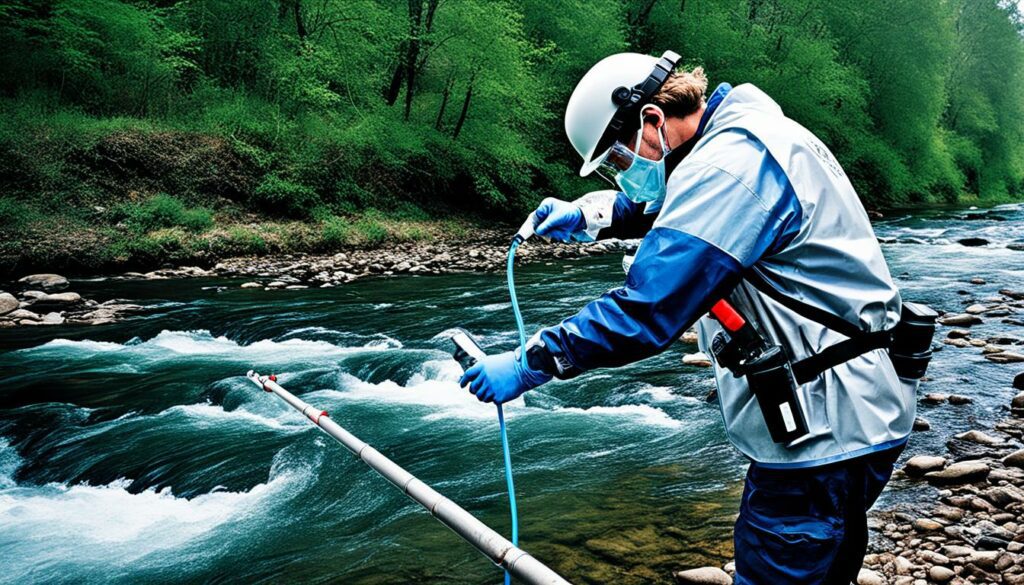
The water’s look and how clean it seems tell us a lot about water quality. If water looks different, it might have unsafe things in it. We watch for these changes to find out if there’s pollution. This helps keep our water safe for plants and animals.
Water heat affects life in the water a lot. Too much heat can hurt plants and animals. Now, we use special tools to check the water’s heat all the time. This keeps the water at the right temperatures for living things.
Smelling the water is important too. Strange smells can warn us about things like factory waste or too many plants. By checking how it smells, we can fix water problems early. This is very good for people and nature living nearby.
Chemical monitoring is key in testing water quality. It helps find and fix specific pollutants. We check different chemical levels to fully understand a waterbody’s health. This identifies issues with water contamination.
Dissolved oxygen in water is crucial for aquatic life. Its levels show how clean the water is. Low levels point to organic pollutants. These can harm the aquatic ecosystem.
Checking pH levels is vital in water testing. It shows if water is acidic or basic. This impacts metal solubility and nutrient availability. Keeping the pH balanced is important. Extreme pH can harm water life and water treatment.
Water tests often check for phosphorus and nitrates. These nutrients, when high, can cause issues. They can lead to too much algae and low oxygen. Testing these nutrients early helps find and fix pollution sources.
By keeping track of these chemicals, we can better manage water. This gives us the right details on water conditions. It helps react quickly to water pollution, keeping the water and its life healthy.
Checking the health of our water is essential, and biological monitoring does just that. It involves looking at the creatures that live in water to understand its condition. Macroinvertebrates, algae, and fish are great at telling us about water quality.
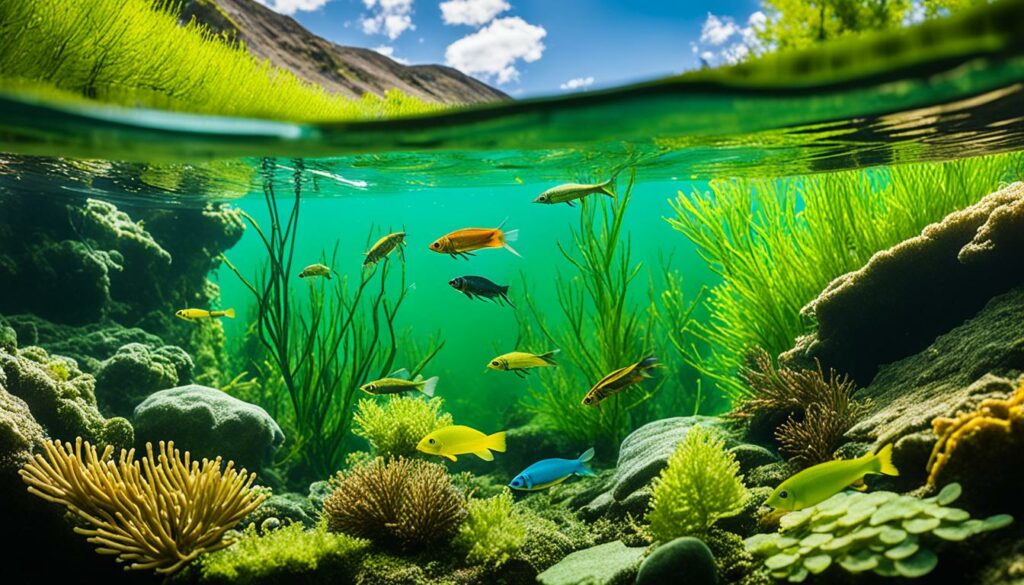
Macroinvertebrates are key because they quickly react to water changes. A study found a strong link between their presence and water pollution levels. They are also simple and cheap to sample, making regular checks easy. This can help ensure our water meets safety standards.
Algae are good at indicating water quality due to their quick growth and nutrient reaction. The Shannon-Weiner index has linked with the amount of algae, showing a pattern with pollution levels. Observing algae can tell us if the water is clean or not, aiding regular quality checks.
Fish and invertebrates give us a wide view of water health. By looking at their wellbeing, we understand the impact of the environment. A study found that Water body II was healthier than Water body I, in line with both physical and living species’ assessments. The insects feeding fish show local environmental health and the success of cleanup work. This approach highlights the role of wildlife in ongoing water quality checks.
Below is a comprehensive comparison table highlighting significant correlations:
| Index/Parameter | Correlation Coefficients (r) | Statistical Significance (p) |
|---|---|---|
| Biological Pollution Indices | >0.316 | ≤ 0.05 |
| Nyggard’s Index | >0.356 | ≤ 0.05 |
| Shannon-Weiner Index (Phytoplankton Density) | >0.415 and 0.327 | ≤ 0.05 |
Using the best environmental monitoring practices is key to controlling water quality effectively. With advanced technology for data, we get accurate insights. For example, the New York State Health Department demands stricter standards for drinking water than the EPA. This shows the need for tough rules to ensure top-notch water.
It’s important to report water use thoroughly. In New York, systems that draw more than 100,000 gallons of water a day must report yearly. This rule helps us watch how much water we use and supports using water wisely.
Keeping up with local, regional, and national water quality laws is crucial. Regulations often change. Those in charge need to stay informed to follow the rules and update their methods. The U.S. Clean Water Act shows this need by directing states to set water use standards.
New York’s work on TMDLs for places like Long Island Sound and Lake Champlain shows the focus on reducing pollution. Managing stormwater well is also important to keep water oxygen levels right. This stops fish from dying due to low oxygen.
Good monitoring practices deal with too much water plant growth in various ways. This can be through measures like prevention, natural practices, or even the use of chemicals. Regular checks are key. They show us where and what changes need to be made to manage water well.
Water contamination is a serious health risk, causing over 80% of diseases, reports WHO. By following strict rules and collecting data regularly, we can protect people’s health. This approach also ensures we use water in a way that keeps it safe for us all.
| Practice | Benefits |
|---|---|
| Annual Water Usage Reports | Maintains accurate water consumption data, supports sustainable management |
| Staying Informed on Regulations | Ensures compliance, enables adaptive management |
| Utilising TMDLs | Targets pollution reduction, supports specific waterbodies |
| Preventing Excessive Aquatic Growth | Maintains dissolved oxygen, prevents fish kills |
| Regular Water Quality Monitoring | Identifies need for corrective actions, assesses BMP effectiveness |
| Routine Health Checks | Safeguards public health, reduces disease risks |
It’s key to know and follow regulatory water quality standards for good water quality management. These rules make sure our water sources are safe and used in a way that keeps people and the environment healthy. Laws at state and national levels are very important for keeping our water clean.
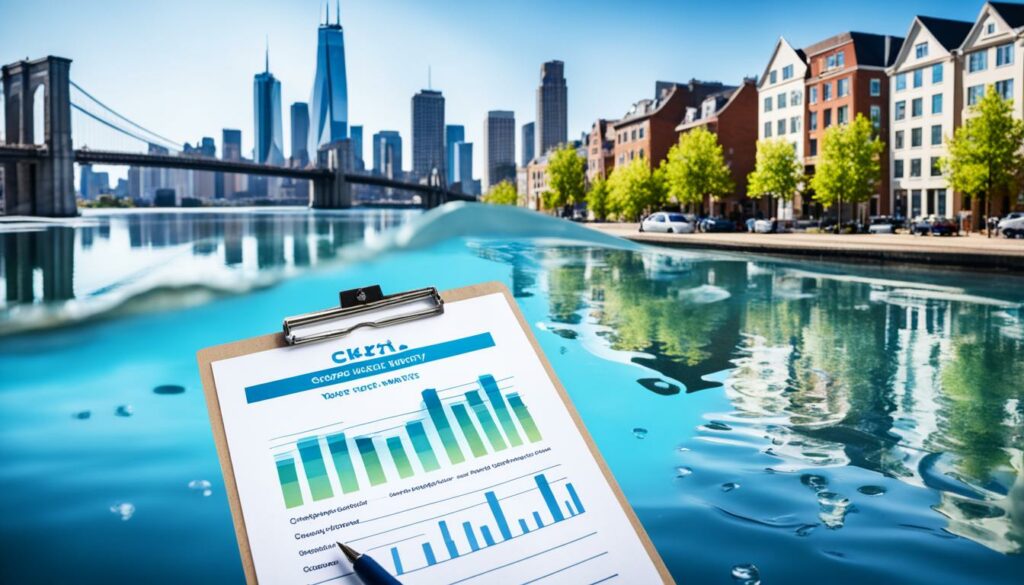
Rules for surface water help keep lakes, rivers, and streams clean and safe. In New York, Article 24 of its laws needs permits for certain activities near wetlands. Also, there are rules called TMDLs by NYSDEC to limit pollutants in water that doesn’t meet quality standards. These laws mean water use must not harm its current best use.
Managing how we use and protect groundwater is also critical. For example, in New York, if a system takes out over 100,000 gallons daily, it must report its usage each year. And any drawing of groundwater should not hurt its long-term health. These rules are set to keep this important water source safe for everyone.
The goal of drinking water standards is to make sure what we drink is safe. The Safe Drinking Water Act since 1974 has been essential for protecting water. New York State, going beyond federal rules, has even stricter standards. This aims to keep people healthy by checking for and preventing harmful chemicals like lead and bacteria.
| Regulation | Area Covered | Specific Measures |
|---|---|---|
| Article 24 of NY Environmental Conservation Law | Wetlands and Adjacent Areas | Permits required for activities |
| Safe Drinking Water Act (1974) | Public Drinking Water | Ensures water quality through standards |
| NYSDEC TMDLs | Impaired Waterbodies | Sets limits on nitrogen, phosphorus, and sediments |
| Dishwater Detergent and Nutrient Runoff Law | Surface Water | Reduces nutrient pollution |
A good approach to water quality management includes knowing and respecting regulatory water quality standards. It aims to protect both ground and surface water for everyone today and in the future.
Effective water treatment solutions are crucial for water quality management. They deal with various sources of pollution. Water systems use steps like coagulation, flocculation, and more to keep water safe to drink.
Coagulation starts by adding positive chemicals. They make the negative dirt and particles change. Then, in flocculation, the water is gently mixed to create bigger particles. This stage is faster with the help of some chemicals.
In the sedimentation phase, the big particles sink to the bottom. This step gets rid of solids in the water. Filtration happens next. Water passes through materials like sand and charcoal. They remove particles and harmful stuff like bacteria. Some systems use advanced ways to filter, like ultrafiltration.
After filtration comes disinfection. Chemicals like chlorine are added to kill any remaining germs. Without chemicals, UV light or ozone can also be used.
Changing the water’s pH and adding fluoride follows. This makes water taste better. It also fights against germs and helps teeth stay healthy. These steps ensure water is not harmful and is enjoyable to drink.
| Water Treatment Steps | Description | Purpose |
|---|---|---|
| Coagulation | Addition of chemicals with positive charge | Neutralise negative charge of dirt |
| Flocculation | Gentle mixing of water | Form flocs through further chemical addition |
| Sedimentation | Settling down of flocs | Separate solids from water |
| Filtration | Passing water through filters | Remove particles, chemicals, parasites, bacteria, and viruses |
| Disinfection | Adding chemical disinfectants | Eliminate remaining germs |
| pH Adjustment | Water pH balancing | Improve taste and reduce pipe corrosion |
| Fluoride Addition | Adding fluoride | Promote dental health |
By using these steps, we can manage water quality well. We deal with pollution and make sure water is safe and good for use.
Keeping our water supply safe and clean is crucial. We need to start with a water quality assessment. This helps find out what’s polluting our water and where it’s coming from. Whether it’s from everyday activities or big factories, knowing the pollutants helps choose the right fixes.
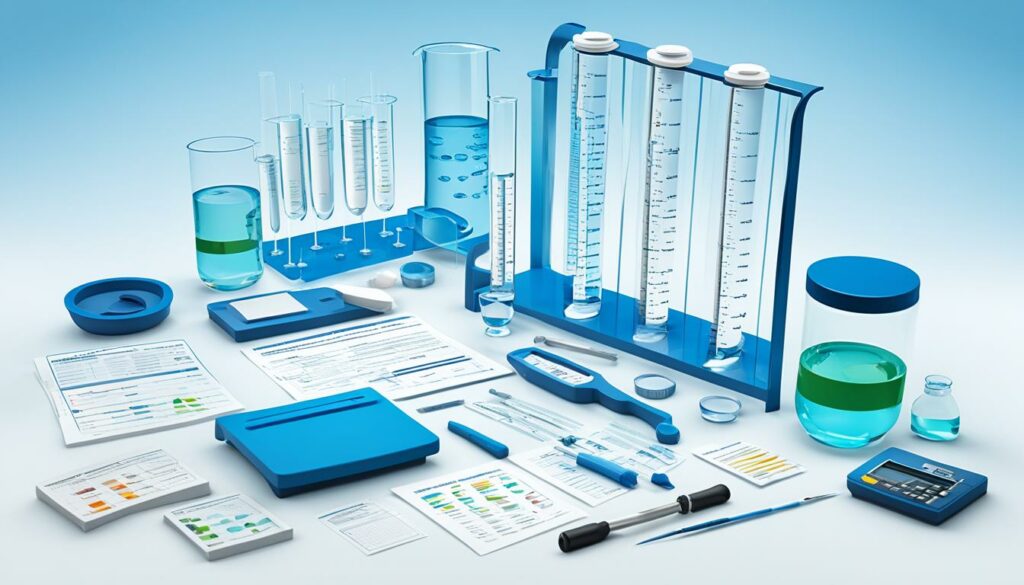
To clean up our water effectively, we must know what’s in it. In Minnesota, the MPCA checked their water for 10 years. They found that 86% of the pollution comes from everyday activities, not big factories. Things like nitrogen from fertilizers are a big part of this. They are now focusing on finding solutions for these issues.
After finding the pollutants, it’s time to act. Minnesota is taking steps through its Clean Water Fund. They’re working hard over 25 years to reduce pollution. This includes using money from local and federal programs. So far, they’ve made real progress because of these efforts.
In Utah and Louisiana, they’re taking different but effective approaches. Utah’s DEQ is getting the public involved and making stronger rules to stop pollution. On the other hand, Louisiana is tackling pollution from farms, cities, and industries together. They’re using smart plans and a lot of money to fight water pollution.
By working together and using smart strategies, we protect our water. This way, we make sure it stays clean for the next generations.
Water testing is key in keeping our water safe. It helps us understand how healthy water is and if our control methods are working. By checking things like oxygen, pH, and if pollution is affecting living things in the water, we can find problems early. This way, we stop these issues from getting big.
Drinking dirty water can cause over 80% of diseases according to the WHO. This is why testing water is so important. The EPA in the U.S. sets rules to keep our drinking water safe. Constant testing matches these rules, helping to manage water quality well.
Testing also looks at dissolved oxygen, which is crucial for water life. The right pH level, between 6.5-8.5, supports life. And high conductivity might show pollution, affecting water health.
We check for harmful stuff in water, like phosphorus, to avoid problems like low oxygen levels. Too much algae can also mean bad conditions for water life. Testing for solids in the water can tell us if something is stopping plants from growing, like silt.
We use many tests to understand water health, like checking how clear water is (Secchi disk) or looking at the life in water. Following the right tests often and using agreed rules are crucial for good results. But, some places can’t test well due to small budgets or not enough equipment. This means we need to work harder to keep water safe everywhere.
Making sure our water tests are correct and useful is very important. Programs where people check the water themselves also help a lot. They look at the water’s movement and its oxygen and see why the water might not be clean, which is very helpful.
Water testing is a big part of looking after water quality. It gives us the facts we need to see if water is in good shape and what to do if it’s not. By improving our testing, we can better protect our precious water for the future.
Best Management Practices (BMPs) are key for top water quality. They use environmental monitoring and water management practices. These methods help control issues from activities such as making forest roads, cutting trees, and using pesticides. These could lead to pollution without these approaches.

The Department of Forestry (DOF) achieves a 95% BMP success rate across the state. They help with planning cuts, offering BMP advice, and renewing sites. Their yearly reports on Best Management Practices show the need for regular environmental monitoring for better practices.
BMPs deal with stormwater to guard water quality. Water management practices help control sediments and nutrients in drainage from tree activities. Features like channels, basins, and zones prevent soil loss and water pollution.
Keeping lakes and ponds healthy means using BMPs. They target nutrient, sediment, and temperature issues. DOF helps owners and operators keep these waters in good shape. Actions like stabilising shores, controlling water plants, and checking quality save these important areas.
Checking water quality constantly is key. It ensures water stays at its best. A mix of checks and tech helps with this.
“Continuous monitoring ensures that water quality objectives are consistently met and provides timely responses to emerging issues.”
Many people, both volunteers and experts, work together to manage water quality. By following these steps, we make sure the water’s always safe.
| Source | Common Chemical Pollutants |
|---|---|
| Cropland | Turbidity, phosphorus, nitrates, temperature, total solids |
| Forestry Harvest | Turbidity, temperature, total solids |
| Grazing Land | Fecal bacteria, turbidity, phosphorus, nitrates, temperature |
| Industrial Discharge | Temperature, conductivity, total solids, toxics, pH |
| Mining | pH, alkalinity, total dissolved solids |
| Septic Systems | Fecal bacteria, nitrates, phosphorus, dissolved oxygen/biochemical oxygen demand, conductivity, temperature |
| Sewage Treatment Plants | Dissolved oxygen and biochemical oxygen demand, turbidity, conductivity, phosphorus, nitrates, fecal bacteria, temperature, total solids, pH |
| Construction | Turbidity, temperature, dissolved oxygen and biochemical oxygen demand, total solids, toxics |
| Urban Runoff | Turbidity, phosphorus, nitrates, temperature, conductivity, dissolved oxygen and biochemical oxygen demand |
In summary, following these steps closely helps manage water quality well. It lets us tackle issues early on.
Water quality strategies can work well in different ways. Looking at success stories gives us great lessons. For example, point source-nonpoint source trading is a powerful method. It was most used in the U.S. in 2005 and saved a lot of money. This way of trading can get farmers to reduce pollution by offering them incentives. This shows new ways we can motivate people to help clean water.
Trading works better in big areas with lots of people. This is because there are more people to buy and sell credits. But in smaller areas, trading is more difficult. This is because there are fewer people to trade with. It’s interesting to note that in the U.S., trading often happens between big and small polluters in larger areas. Here, there are more opportunities for trading to happen smoothly.
Some places have already shown that trading can really improve water quality. Let’s take Lake Winnipeg for instance. Over 200 places were adding too much phosphorus to the lake. This was making the water too rich in nutrients. Looking at programs like the Lake Simcoe Phosphorus Offsetting Program and the South Nation Conservation trading program, we can see how different places are tackling the issue. These programs from Canada, the U.S., and New Zealand show that different approaches can work.
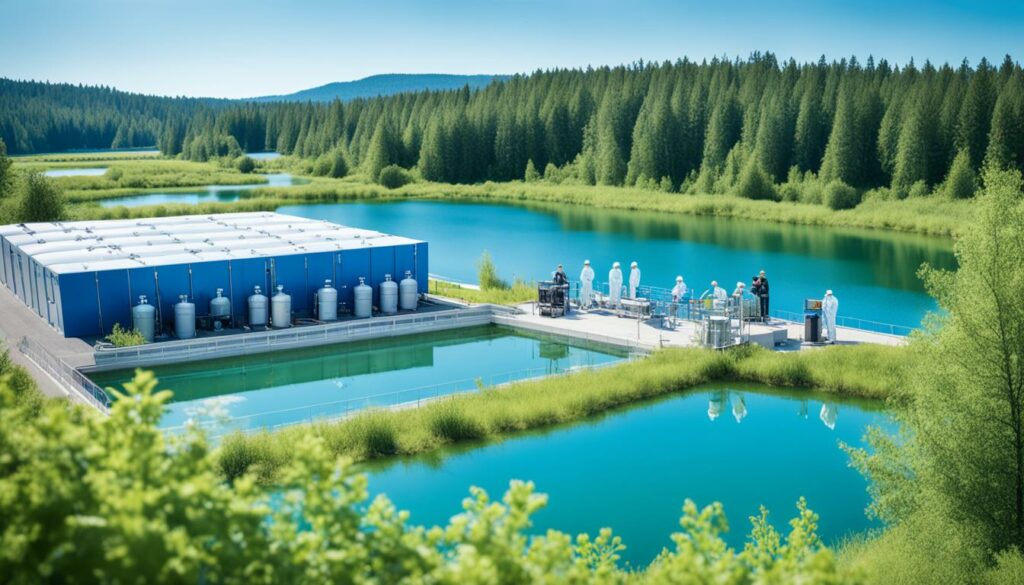
The main approach in many successful programs is from point sources to nonpoint sources. But there’s also exploration of other trading types. For instance, you can trade between similar sources or promote good land management. The success of these methods often depends on how much it costs to reduce pollution. This impacts if and how well each trading strategy works within a community.
Key to these programs is working closely with farmers. Some approaches let farmers earn money from different sources for helping the environment. Laws and money incentives are very important in making these programs work. They make sure that everyone is doing their fair share to keep the water clean.
| Program | Region | Components | Results |
|---|---|---|---|
| Lake Simcoe Phosphorus Offsetting Program | Canada | Phosphorus trading, stewardship incentives | Reduction in lake eutrophication |
| South Nation Conservation Program | Canada | Phosphorus trading, community engagement | Enhanced water quality |
| Point Source-Nonpoint Source Trading | U.S. | Voluntary pollution reduction, agricultural incentives | Significant cost savings, improved watershed health |
In conclusion, managing water quality well is crucial for dealing with many water issues. The approach in Oregon shows how to handle water quantity, quality, and what nature needs while facing more people and climate change. Oregon uses a special index to check water’s health, looking at things like oxygen levels and nutrients.
Keeping water clean needs everyone to work together, and strict rules help, like those updated every two years under the Clean Water Act. In Oregon, the Department of Fish and Wildlife and the Agriculture Department help a lot. They control pests and make plans to keep water clean in specific areas. This includes stopping erosion and managing nutrients and waste.
The Oregon Department of Environmental Quality makes sure there’s only a certain amount of pollution allowed each day. This is very important for working with the river’s natural seasons and needs. Cleaning the water before we use it is a must, to lower pollution and keep everyone safe. This is done following strict rules by the WHO and EU.
To end, we must always check and follow the rules to keep water safe. With regular checks and changing plans when needed, we can solve water problems. Together, by making smart choices, we can keep our environment healthy for all life.
Water quality management checks and keeps water clean for all life. It includes testing and fixing any issues to keep water safe and healthy.
More than 80% of diseases come from dirty water. Keeping water clean means healthier drinking water, stopping diseases, and keeping people well.
We measure water by looking at its physical, chemical, and biological makeup. This includes things like how much oxygen it has, its pH, and what life is in it. These show if the water is in good shape.
Water quality depends on how the water looks, its chemicals, and its life. Things like flow rate, oxygen levels, and the types of aquatic animals tell us if water is clean.
Testing water involves looking at its physical features (like colour), chemicals (oxygen and pH), and life in it. This helps us understand how clean the water is.
Dirty water harms plants and animals, leading to less variety in nature. It disrupts normal life processes in the water, affecting everything that relies on it.
To treat dirty water, we use physical, chemical, and biological ways to remove the bad stuff. Methods include filtering, disinfecting, and using natural processes with plants or bacteria.
Regulatory bodies make rules to keep water safe and environmental rules. They check if people follow these rules and make sure the right things are being done.
Best Management Practices (BMPs) are smart ways to protect water. They include good strategies based on science for areas like stormwater and managing lakes and ponds.
Keeping an eye on water quality means always checking, improving steps, and using new ways to guarantee water is safe. It’s a way to keep water at high quality all the time.
Seeing how others have cleaned up and protected water helps us learn. These successes show what we can do to make water cleaner and better for everyone.